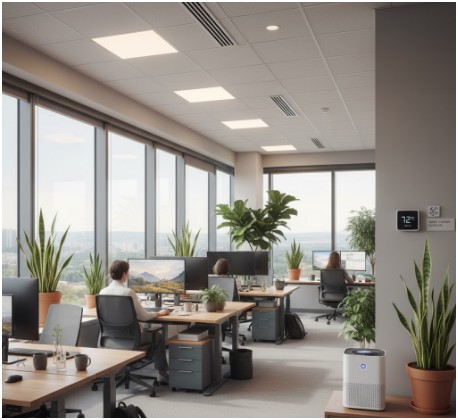Employee well-being has become a critical factor in workplace success. Companies that invest in creating supportive environments see higher productivity, reduced turnover, and improved morale. But what does it actually take to build a workspace that puts employee health and happiness first?
The shift toward well-being-focused workplaces isn’t just a trend—it’s a necessity. Research shows that employees who feel supported at work are 31% more productive and three times more likely to stay with their company. This means creating spaces that address both physical comfort and mental health needs.
Design Physical Spaces for Comfort and Health

The foundation of employee well-being starts with the physical environment. Natural light plays a crucial role in maintaining circadian rhythms and boosting mood. Position desks near windows when possible, and supplement with full-spectrum lighting in areas without natural light access.
Temperature control matters more than many leaders realize. Studies indicate that productivity drops significantly when office temperatures fall outside the 68-76°F range. Installing individual temperature controls or zoned HVAC systems helps accommodate different comfort preferences.
Air quality directly impacts cognitive function and overall health. Regular HVAC maintenance, indoor plants, and proper ventilation systems reduce pollutants and create fresher breathing environments. Consider adding air purifiers in high-traffic areas or spaces with limited airflow.
Invest in Ergonomic Solutions
Poor ergonomics contribute to workplace injuries and long-term health issues. Quality office workstations should include adjustable desks, supportive chairs, and proper monitor positioning to reduce strain on necks, backs, and wrists.
Standing desk options allow employees to alternate between sitting and standing throughout the day. This simple change can reduce back pain, improve posture, and increase energy levels. Provide anti-fatigue mats and footrests to maximize comfort during standing periods.
Keyboard and mouse placement deserves attention too. Adjustable keyboard trays and ergonomic accessories help maintain neutral wrist positions, preventing repetitive strain injuries that can sideline employees for weeks or months.
Create Spaces for Mental Restoration

Mental well-being requires dedicated spaces where employees can decompress and recharge. Quiet zones or meditation rooms provide refuge from open office noise and distractions. These spaces don’t need elaborate setups—comfortable seating, soft lighting, and sound dampening materials create effective retreat areas.
Break rooms should feel welcoming rather than utilitarian. Comfortable furniture, plants, games, and quality coffee equipment encourage social interaction and genuine breaks from work tasks. Avoid placing break rooms too close to high-traffic areas to maintain their restorative function.
Outdoor access, even through small patios or rooftop gardens, provides mental health benefits. Fresh air and nature views help reduce stress hormones and improve focus when employees return to their tasks.
Promote Movement and Physical Activity
Sedentary work takes a toll on physical health. Encourage movement by creating walking paths, installing bike racks, or offering on-site fitness facilities. Even small changes like placing printers away from desks naturally increase daily movement.
Active workstations like treadmill desks or balance ball chairs offer alternatives for employees who want to incorporate movement into their work routine. While these aren’t suitable for everyone, providing options demonstrates commitment to diverse wellness needs.
Stairwell improvements—better lighting, motivational signage, or artwork—encourage employees to choose stairs over elevators. This simple infrastructure change can significantly increase daily physical activity levels.
Foster Social Connection and Community

Well-being extends beyond individual health to include social connections. Common areas with flexible seating arrangements encourage informal interactions and relationship building. These connections become especially important for remote or hybrid workers who may feel isolated.
Collaboration spaces should accommodate different working styles and group sizes. Some employees thrive in open, energetic environments, while others need quieter spaces for focused teamwork. Providing variety ensures everyone can find their optimal working conditions.
Consider hosting regular wellness activities like group walks, healthy cooking demonstrations, or stress management workshops. These events build community while reinforcing the company’s commitment to employee health.
Support Work-Life Balance Through Policy
Physical spaces mean little without supportive policies. Flexible work arrangements, including remote work options and flexible hours, help employees manage personal responsibilities alongside professional duties.
Encourage actual lunch breaks by creating policies that protect this time. When leaders model healthy break-taking behavior, employees feel more comfortable doing the same.
Mental health support through employee assistance programs, counseling services, or mental health days shows genuine care for employee well-being beyond productivity metrics.
Building a Culture of Well-Being That Lasts
Creating well-being-focused workspaces requires ongoing attention and adjustment. Regular employee surveys help identify what’s working and what needs improvement. Pay attention to utilization patterns—spaces that remain empty may need redesign or different purposes.
Leadership commitment makes the difference between successful wellness initiatives and forgotten good intentions. When executives prioritize their own well-being and use wellness spaces, employees follow suit.
Remember that well-being investments pay dividends through reduced healthcare costs, lower turnover, and higher productivity. Companies that prioritize employee wellness create competitive advantages that extend far beyond their office walls.
The most successful wellness-focused workspaces evolve with employee needs and company growth. Start with foundational changes and build momentum through employee feedback and measurable improvements in satisfaction and performance metrics.









